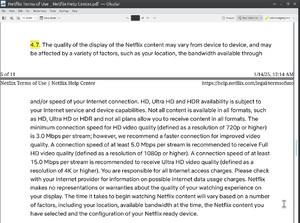Please note that all submissions to the site are subject to the wiki's licence, CC 4.0 BY-SA, as found here
Netflix 4K Stream Quality Controversy
Netflix
Netflix places limits on your ability to receive a 4k stream and does not disclose all conditions under which these limits apply. Netflix defaults users to the 4K premium plan when signing up new users, while obfuscating the fact that they place willful, purposeful limitations on your ability to receive a 4K stream. If users were fully informed of these limitations, they might elect to not subscribe to the more expensive plan that netflix defaults new customers to; but this information is not provided to the customer. This would not be an issue if Netflix provided this information upfront, but they do not. This is even worse than the EULA roofie[1] , as all prerequisites to receive a 4k stream are not even listed in the terms of use[2], terms & conditions[3], or help page[4].
Netflix, in their Terms of Service (TOS), lists reasons why the quality of its content may vary from different devices, as stated in clause 4.7: "The quality of the display of the Netflix content may vary from device to device, and may be affected by a variety of factors, such as your location, the bandwidth available through and/or speed of your Internet connection." One of the factors not listed is the use of Widevine, a Digital Rights Management (DRM) software which is embedded into most web browsers such as Chrome, Chromium, Electron (CEF), Firefox, Edge, Opera, Safari, etc. A DRM protects media hosted on Netflix from being screen-captured, with one of the methods using "SECURE_DECODE", which uses Widevine to decode each frame displayed. This method demands more bandwidth, with Netflix appeasing the disparity by decreasing the quality to 720p on web browsers.
Currently, Netflix offers 1080p video resolution on every plan they offer on their Plans and Pricing for a subscription. Consumers who watch Netflix on web browsers will be paying for 1080p resolution while only receiving 720p resolution maximum due to DRM. The TOS allows Netflix to claim your device faulty or your internet speed slow to justify this behavior.


The only time you see there are any limitations is in incredibly small font, on the bottom of the page where you choose a plan. The 4k HDR option is the default option and has an icon with very appealing colors that draw your eyes to this more expensive option, while you must scroll to the bottom to even be linked to a document that explains the limitations.[5] The explanation provided on this terms of service that must be dug through, is completely inadequate. See below:
Terms of Service Analysis
Netflix's Terms of Service (TOS) obscures important information about video quality limitations in Section 4.7, which vaguely states:
"HD, Ultra HD and HDR availability is subject to your Internet service and device capabilities. Not all content is available in all formats, such as HD, Ultra HD or HDR and not all plans allow you to receive content in all formats."
Currently, Netflix offers 1080p video resolution on every plan they offer on their Plans and Pricing for a subscription. Consumers who watch Netflix on web browsers will be paying for 1080p resolution while only receiving 720p resolution maximum due to DRM. The TOS allows Netflix to claim your device faulty or your internet speed slow to justify this behavior.
Netflix's Terms of Service (TOS) obscures important information about video quality limitations in Section 4.7, which vaguely states:
4.7. The quality of the display of the Netflix content may vary from device to device, and may be affected by a variety of factors, such as your location, the bandwidth available through and/or speed of your Internet connection. HD, Ultra HD and HDR availability is subject to your Internet service and device capabilities. Not all content is available in all formats, such as HD, Ultra HD or HDR and not all plans allow you to receive content in all formats. The minimum connection speed for HD video quality (defined as a resolution of 720p or higher) is 3.0 Mbps per stream; however, we recommend a faster connection for improved video quality. A connection speed of at least 5.0 Mbps per stream is recommended to receive Full HD video quality (defined as a resolution of 1080p or higher). A connection speed of at least 15.0 Mbps per stream is recommended to receive Ultra HD video quality (defined as a resolution of 4K or higher). You are responsible for all Internet access charges. Please check with your Internet provider for information on possible Internet data usage charges. Netflix makes no representations or warranties about the quality of your watching experience on your display. The time it takes to begin watching Netflix content will vary based on a number of factors, including your location, available bandwidth at the time, the Netflix content you have selected and the configuration of your Netflix ready device.
Netflix 4K Streaming Prerequisites & Lack of Disclosure
1. Complete List of Prerequisites for Netflix 4K Streaming {NEEDS CITATIONS, THIS IS BASED ON UNCONFIRMED USER REPORTS}
- Netflix Premium Plan: Subscription to the Premium Plan. made obvious by netflix
- Device Compatibility: Devices must support 4K playback and be Netflix-certified.
- Display Requirements: A screen with a resolution of at least 3840x2160 and HDCP 2.2-compliant HDMI ports (for external displays). HDCP compliant HDMI ports is only made obvious on a help page not linked to on the signup page or the terms of use linked to on the signup page.
- DRM Support: Hardware-based DRM like Widevine L1, PlayReady 3.0, or FairPlay is required.
- HEVC Codec Support: Devices must support HEVC (H.265) codec for 4K playback.
- Internet Speed: A stable internet connection of at least 15 Mbps.
- Operating System: Supported OS versions, e.g., Windows 10/11, macOS (Safari), and specific Android/iOS versions.
- Browser/App Compatibility: Certain browsers (e.g., Microsoft Edge, Safari) and official Netflix apps are required.
- Updated Firmware/Software: Devices must run the latest firmware or software.
- Title Availability: Not all titles are available in 4K; the content must be marked as 4K or UHD.
2. Prerequisites Disclosed on the Netflix Help Page
- Subscription Plan: The need for the Premium Plan for 4K content.
- Internet Speed: The recommendation of 15 Mbps for 4K streaming.
- Device Compatibility: Making sure all devices in the setup support 4k video playback
- Display Requirements: Mention of HDCP 2.2-compliant HDMI ports and display resolution for external devices.
- Account Settings: Instructions to set playback settings to High or Auto for 4K.
- Title Verification: Guidelines on identifying titles that support 4K or HDR.
3. Prerequisites Netflix Does NOT Disclose on the Help Page
- DRM Requirements: There is no explicit mention of the need for Widevine L1, PlayReady 3.0, or FairPlay DRM.
- Codec Support: The necessity of HEVC (H.265) support is not detailed.
- Browser Limitations: Restrictions on browsers for 4K playback, such that only Edge and Safari are supported, are omitted.
- Operating System Versions: Specific operating system version requirements are not highlighted.
- Processor Capabilities: The requirement for devices with processors capable of decoding HEVC efficiently is not mentioned, even though this is not a pre-requisite to play back HEVC video.
- Firmware Updates: While it suggests keeping devices updated, there is no detail on the necessity for specific firmware versions for 4K.
- Mobile Device Limitations: It mentions HDR might not stream on mobile devices in low power mode but does not address limitations like Widevine DRM levels.
Summary
Netflix discloses many prerequisites for 4K streaming. However:
1. They only disclose that there is a limitation on the bottom of the signup page.
2. The URL on the bottom of the signup page links to a terms of use page that provides no tangible information on what is necessary to obtain a 4k stream.[6]
3. The help page on how to receive a 4k stream is not linked on either the signup page, or the terms of use.[7]
4. The help page on how to receive a 4k stream excludes many of the prerequisites necessary to receive a 4k stream.
- Many users may have opted out of paying extra for the 4K plan if they knew that they had to jump through these hoops to receive a 4K stream.
- Many users may have opted out of paying extra for the 4K plan if they realized that netflix does not even provide you with the information on what qualifies & disqualifies you from receiving a 4K stream.
- Netflix does not make this information prominently available to the customer, and uses language that implies your internet connection or hardware is the problem, in spite of the fact that your hardware & internet connection may be perfectly adequate for 4K playback of a high bitrate, 4k HEVC stream.
Key Issues
1. Lack of Transparency
- The TOS does not explicitly list supported hardware
- The TOS claims the issue may be your device's capabilities, without mentioning that Netflix places specific limitations on what devices are capable of.
- Whether a device is CAPABLE of high bitrate, 4k video playback is not the issue; Netflix chooses to send a low bitrate, low resolution stream to specific devices, and does not provide you with the prerequisites necessary to receive a 4k stream. The reality is that Netflix ACTIVELY LIMITS what devices will work in 4k without disclosing what those limits are to you.
- No clear information about browser limitations to 720p due to DRM
- No direct way to determine if a device is "Netflix ready"
2. Buried Information
- The only time you see there are any limitations is in incredibly small font, on the bottom of the page where you choose a plan
- The 4k HDR option is the default option and has an icon with very appealing colors that draw your eyes to this more expensive option
- Users must scroll to the bottom to even be linked to a document that explains the limitations
3. Inadequate Disclosure
- Section 4.9 deflects responsibility by telling users to "look solely to the entity that manufactured and/or sold you the Netflix ready device"; without providing any information to you, or the manufacturer of your computer/operating system, on what prerequisites exist for that device to receive a 4k stream from netflix.
- The explanation provided in the terms of service, which must be dug through, is completely inadequate
- No clear guidance on how to determine device compatibility before subscribing
This represents a modern consumer protection issue where technical limitations put in place by the vendor to retain control over your experience negatively affect service quality and are obscured from consumers at the point of purchase; while still charging premium prices for resolutions that they knowingly restrict many devices, browsers, operating systems, and hardware form playing back; even if they are fully capable of doing so.
- ↑ EULA roofie
- ↑ https://help.netflix.com/legal/termsofuse
- ↑ https://www.netflix.shop/pages/terms-conditions
- ↑ https://help.netflix.com/en/node/13444
- ↑ https://web.archive.org/web/20250111144808/https://help.netflix.com/legal/termsofuse
- ↑ https://web.archive.org/web/20250111144808/https://help.netflix.com/legal/termsofuse
- ↑ https://help.netflix.com/en/node/13444